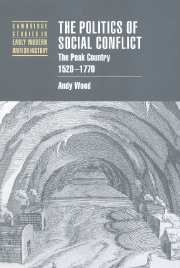Book contents
- Frontmatter
- Contents
- List of figures
- List of tables
- List of maps
- Preface
- List of abbreviations
- Introduction ‘Terms we did not understand’: landscape, place and perceptions
- 1 Social relations and popular culture in early modern England
- Part I The structures of inequality
- Part II The conditions of community
- Part III The politics of social conflict
- 9 ‘Pyllage uppon the poore mynorz’: sources of social conflict, 1500-1600
- 10 ‘All is hurly burly here’: local histories of social conflict, 1600-1640
- 11 The peak in context: riot and popular politics in early Stuart England
- 12 ‘Prerogative hath many proctors’: the English Revolution and the plebeian politics of the Peak, 1640–1660
- 13 The experience of defeat? The defence of custom, 1660–1770
- 14 The making of the English working class in the Derbyshire Peak Country
- Bibliography
- Index
- Cambridge Studies in Early Modern British History
14 - The making of the English working class in the Derbyshire Peak Country
Published online by Cambridge University Press: 27 July 2009
- Frontmatter
- Contents
- List of figures
- List of tables
- List of maps
- Preface
- List of abbreviations
- Introduction ‘Terms we did not understand’: landscape, place and perceptions
- 1 Social relations and popular culture in early modern England
- Part I The structures of inequality
- Part II The conditions of community
- Part III The politics of social conflict
- 9 ‘Pyllage uppon the poore mynorz’: sources of social conflict, 1500-1600
- 10 ‘All is hurly burly here’: local histories of social conflict, 1600-1640
- 11 The peak in context: riot and popular politics in early Stuart England
- 12 ‘Prerogative hath many proctors’: the English Revolution and the plebeian politics of the Peak, 1640–1660
- 13 The experience of defeat? The defence of custom, 1660–1770
- 14 The making of the English working class in the Derbyshire Peak Country
- Bibliography
- Index
- Cambridge Studies in Early Modern British History
Summary
To contemporaries and to modern social historians alike, the late eighteenth-century factory system seemed to spawn the class structure which subsequently dominated nineteenth- and twentieth-century Britain. There was something about the ordered, ugly, oppressive uniformity of the tall mills of northern England which seemed to call forth an ordered, ugly, oppressive, uniform class society. For both radical democrat and nostalgic Tory, the factory system marked the antithesis of the consensual, harmonious rural society which they imagined had existed before enclosure. William Cobbett and John Clare established the same connection between class, enclosure, immiseration and industry, as did, much later, Benjamin Disraeli and James Keir Hardie. The belief that late eighteenth-century Britain had experienced a moment of jolting transition in which it had moved from a harmonious rural society into an industrial class society was later given choate form in the terminology of industrial revolution.
As a region which experienced the early arrival of the factory system, in the shape of the establishment of Arkwright's mill at Cromford in 1771, perceptions of the Peak became central to changing views of industry and society in later eighteenth-century Britain. John Byng, who visited the Peak in 1790, recalled the tall cotton mills at Cromford: ‘These cotton mills, seven stories high, and fill'd with inhabitants, remind me of a first rate man of war; and when they are lighted up, on a dark night, look most luminously beautiful.’
- Type
- Chapter
- Information
- The Politics of Social ConflictThe Peak Country, 1520–1770, pp. 316 - 325Publisher: Cambridge University PressPrint publication year: 1999



